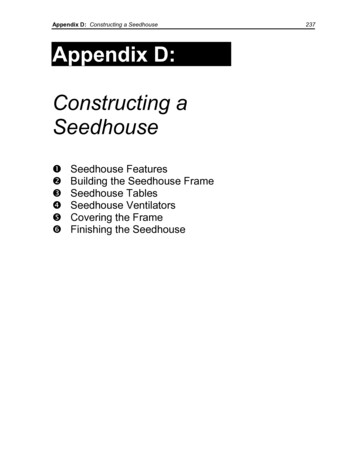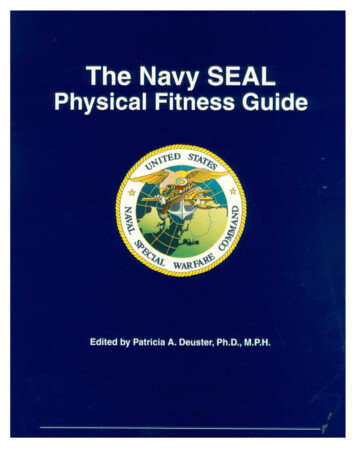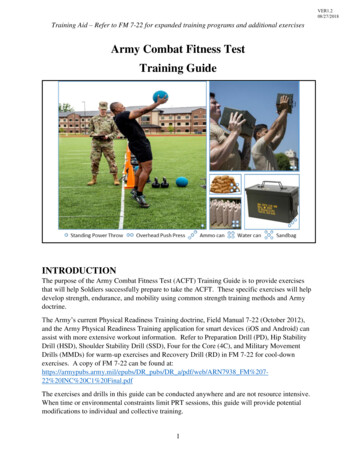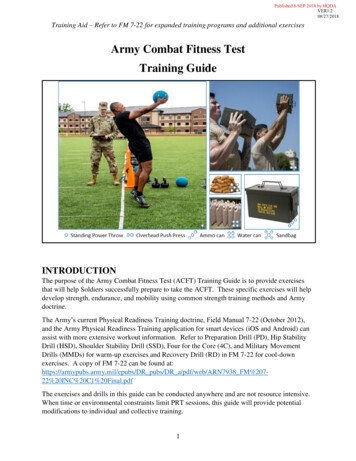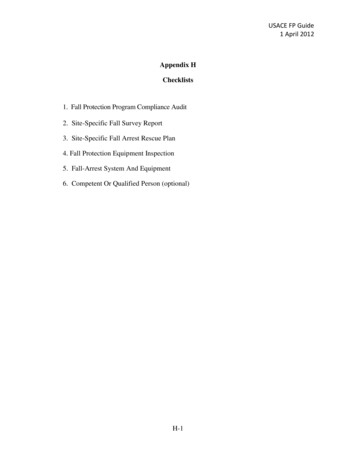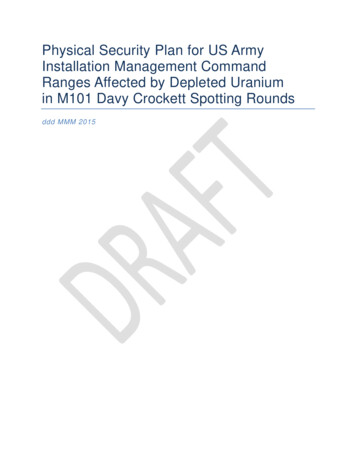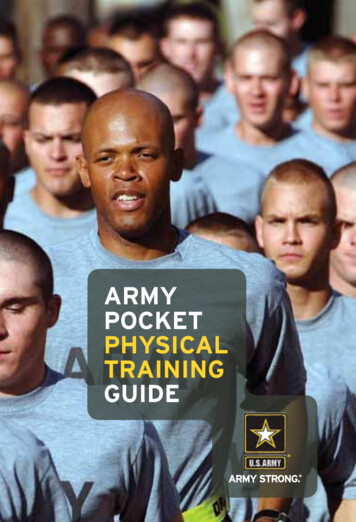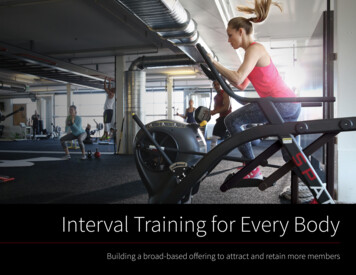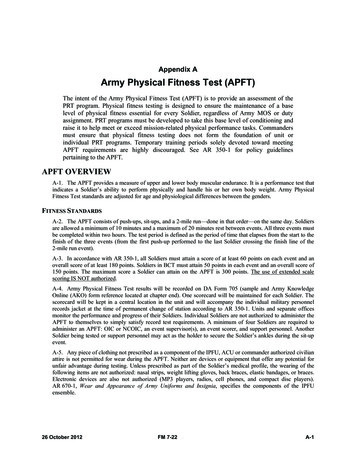
Transcription
Appendix AArmy Physical Fitness Test (APFT)The intent of the Army Physical Fitness Test (APFT) is to provide an assessment of thePRT program. Physical fitness testing is designed to ensure the maintenance of a baselevel of physical fitness essential for every Soldier, regardless of Army MOS or dutyassignment. PRT programs must be developed to take this base level of conditioning andraise it to help meet or exceed mission-related physical performance tasks. Commandersmust ensure that physical fitness testing does not form the foundation of unit orindividual PRT programs. Temporary training periods solely devoted toward meetingAPFT requirements are highly discouraged. See AR 350-1 for policy guidelinespertaining to the APFT.APFT OVERVIEWA-1. The APFT provides a measure of upper and lower body muscular endurance. It is a performance test thatindicates a Soldier’s ability to perform physically and handle his or her own body weight. Army PhysicalFitness Test standards are adjusted for age and physiological differences between the genders.FITNESS STANDARDSA-2. The APFT consists of push-ups, sit-ups, and a 2-mile run—done in that order—on the same day. Soldiersare allowed a minimum of 10 minutes and a maximum of 20 minutes rest between events. All three events mustbe completed within two hours. The test period is defined as the period of time that elapses from the start to thefinish of the three events (from the first push-up performed to the last Soldier crossing the finish line of the2-mile run event).A-3. In accordance with AR 350-1, all Soldiers must attain a score of at least 60 points on each event and anoverall score of at least 180 points. Soldiers in BCT must attain 50 points in each event and an overall score of150 points. The maximum score a Soldier can attain on the APFT is 300 points. The use of extended scalescoring IS NOT authorized.A-4. Army Physical Fitness Test results will be recorded on DA Form 705 (sample and Army KnowledgeOnline (AKO) form reference located at chapter end). One scorecard will be maintained for each Soldier. Thescorecard will be kept in a central location in the unit and will accompany the individual military personnelrecords jacket at the time of permanent change of station according to AR 350-1. Units and separate officesmonitor the performance and progress of their Soldiers. Individual Soldiers are not authorized to administer theAPFT to themselves to simply satisfy record test requirements. A minimum of four Soldiers are required toadminister an APFT: OIC or NCOIC, an event supervisor(s), an event scorer, and support personnel. AnotherSoldier being tested or support personnel may act as the holder to secure the Soldier’s ankles during the sit-upevent.A-5. Any piece of clothing not prescribed as a component of the IPFU, ACU or commander authorized civilianattire is not permitted for wear during the APFT. Neither are devices or equipment that offer any potential forunfair advantage during testing. Unless prescribed as part of the Soldier’s medical profile, the wearing of thefollowing items are not authorized: nasal strips, weight lifting gloves, back braces, elastic bandages, or braces.Electronic devices are also not authorized (MP3 players, radios, cell phones, and compact disc players).AR 670-1, Wear and Appearance of Army Uniforms and Insignia, specifies the components of the IPFUensemble.26 October 2012FM 7-22A-1
Appendix AAPFT ADMINISTRATIONSUPERVISIONA-6. The success of any physical fitness testing program depends on obtaining valid and accurate test results;therefore, the APFT must be administered properly to accurately evaluate individual Soldier and unit physicalfitness. Supervision of the APFT is necessary to ensure the objectives of the physical fitness program are met.Proper supervision provides for standardization in the following: Test preparation. Control of performance factors. Training of test personnel. Test scoring.PREPARATIONA-7. Preparation for the APFT should be directed at securing the most accurate evaluation of personnelparticipating in the test. Preparatory requirements include the following: Selecting and training of event supervisors, scorers, timers, demonstrators, and support personnel. Equipment inventory. Securing the test site.PLANNINGA-8. The commander should ensure that testing is consistent with regard to events, scoring, clothing,equipment, and facilities. Testing should be planned to permit each Soldier to perform at his maximal level andshould ensure the following: Soldiers are not tested when fatigued or ill. Soldiers do not participate in tiring duties before taking an APFT. Weather and environmental conditions do not inhibit physical performance. Risk analysis is conducted.DUTIES OF TEST PERSONNELRESPONSIBILITIESA-9. The Army Physical Fitness Test personnel must be familiar with all aspects of administration of theAPFT. Supervision of Soldiers and laying out the test area are essential duties. The following test personnel arerecommended to conduct an APFT: an OIC and/or NCOIC, an event supervisor(s), a timer, a back-up timer, anevent scorer(s), a demonstrator(s), and support personnel. The minimum number of test personnel required toadminister the APFT is four: an OIC/NCOIC, an event supervisor, an event scorer, and support personnel tohold the Soldiers’ feet on the sit-up event.A-10. The OIC and the NCOIC are responsible for the administration of the APFT. Responsibilities include: Preparation for push-up event (after reading instructions and before test start). Administration of the test. Conduct of recovery upon completion of the test. Procurement of all necessary equipment and supplies. Arrangement and layout of test area. Training of event supervisors, scorers, timer, back-up timer demonstrators, and support personnel. Ensure tests are properly administered and that events are explained, demonstrated, and scoredaccording to standard.A-2FM 7-2226 October 2012
Army Physical Fitness Test (APFT) When test personnel required to administer the APFT are limited, the OIC/NCOIC may performthe duties of an event demonstrator and/or back-up timer.Reports results of test.A-11. The event supervisors are responsible for administration of test events. Responsibility includes thefollowing: Administers one or more test events. Ensures necessary equipment is on hand for each event(s). Reads APFT event instructions. Conducts APFT event demonstration. When test personnel required to administer the APFT are limited, the event supervisor(s) mayperform the duties of the timer. Supervises event scoring to standard. Answers questions on scoring discrepancies and informs the OIC/NCOIC.A-12. The event scorers are responsible for scoring events to standard. Responsibility includes the following: Enforces test standards. Records the correct number of repetitions in the raw score block on DA Form 705. Records initials in initials box on DA Form 705. Performs other duties assigned by the OIC or the NCOIC. Receives training conducted by the OIC/NCOIC to ensure scoring is to standard.A-13. The demonstrators are responsible for demonstrating the push-up and sit-up events to standard.Responsibility includes the following: Assists the event supervisor by demonstrating push-ups and sit-ups to standard during the readingof event instructions. Performs other duties assigned by the OIC or the NCOIC. Receives training, conducted by the OIC/NCOIC, to ensure demonstration of push-ups and sit-upsare to standard.A-14. Timers and back-up timers are responsible for properly timing the push-up, sit-up, and 2-mile run events.A-15. Support personnel assist in preventing unsafe acts to ensure smooth operation of the APFT. The use ofsupport personnel depends on local policy and unit standing operating procedures. For example, supportpersonnel may perform the duties of the holder during the sit-up event. Medical support on site is not requiredunless specified by local policy. The OIC and/or the NCOIC should have a plan for medical support (ifrequired).TEST SITEREQUIREMENTSA-16. The OIC and the NCOIC should select a test site that is flat and free of debris. The test site should havethe following: A site that is free of any significant hazards. A briefing area for the reading of event instructions. A preparation area (can be same as briefing area). A soft, flat, dry area for push-ups and sit-ups. A flat, measure 2-mile running course with a solid surface that is not more than 3 percent grade.A-17. Sound judgment must be used in the selection of a 2-mile run course. There is no requirement to survey2-mile run courses; however, selected test sites should be free of significant hazards such as traffic, slipperyroad surfaces, and areas where heavy pollution is present. Running tracks may be used to administer the 2-milerun event. If a 400-meter track is used, the OIC/NCOIC must add an additional 61 feet, 4 inches to the standard8 laps to ensure the test’s required 2-mile distance is covered. One lap on a 400-meter track is 92 inches shorter26 October 2012FM 7-22A-3
Appendix Athan one lap on a 440-yard track. Eight laps on a 400-meter track is 736 inches shorter than eight laps (2 miles)on a 440-yard tack. Therefore, Soldiers running on a 400-meter track must run an additional 61 feet, 4 inches.TEST PROCEDURESA-18. The APFT test sequence is the push-up, sit-up, and 2-mile run (or an approved alternate aerobic event).The order of events cannot be changed. There are no exceptions to this sequence. Soldiers are allowed aminimum of 10 minutes and a maximum of 20 minutes to recover between events. The OIC or the NCOICdetermines the recovery time. It is normally based on the number of Soldiers taking the test. If large numbers ofSoldiers are being tested, staggered start times should be planned to allow for proper recovery between testevents. Under no circumstances is the APFT valid if Soldiers cannot begin and end all three events in two hoursor less. The following paragraphs describe procedures for APFT administration. On test day, the OIC or theNCOIC briefs Soldiers on the purpose and organization of the test. The OIC or the NCOIC explains testadministration including the scorecard, scoring standards, and test sequence. In addition, the wearing ofunauthorized items such as nasal strips, braces, elastic bandages, weight lifting gloves, electronic devices (MP3players, radios, cell phones, and compact disc players) are addressed. Test instructions for the push-up, sit-up,and 2-mile run (or approved alternate aerobic event) are read prior to conducting preparation. After preparationis completed, the push-up event will begin. From the beginning of the push-up event to the completion of allremaining events, the total time elapsed cannot exceed two hours. Upon completion of all events, recovery willbe conductedA-19. The following instructions are READ aloud to all Soldiers taking the APFT.YOU ARE ABOUT TO TAKE THE ARMY PHYSICAL FITNESS TEST, A TEST THATWILL MEASURE YOUR UPPER AND LOWER BODY MUSCULAR ENDURANCE. THERESULTS OF THIS TEST WILL GIVE YOU AND YOUR COMMANDERS ANINDICATION OF YOUR STATE OF FITNESS AND WILL ACT AS A GUIDE INDETERMINING YOUR PHYSICAL TRAINING NEEDS. LISTEN CLOSELY TO THETEST INSTRUCTIONS, AND DO THE BEST YOU CAN ON EACH OF THE EVENTS.A-20. If DA Form 705 has not been issued, scorecards will be handed out at this time. The OIC or the NCOICwill then instruct the Soldiers to fill in the appropriate spaces with the required personal data. The followinginstructions are READ aloud to all Soldiers taking the APFT:“IN THE APPROPRIATE SPACES, PRINT IN INK THE PERSONAL INFORMATIONREQUIRED ON THE SCORECARD.”Note: The preceding remark is omitted if scorecards were issued prior to arrival at the test site.A-21. Soldiers are then given time to complete the required information. Next, the OIC or the NCOIC explainsprocedures for scorecard use during testing. The following instructions are READ aloud to all Soldiers takingthe APFT:A-4FM 7-2226 October 2012
Army Physical Fitness Test (APFT)“YOU ARE TO CARRY THIS CARD WITH YOU TO EACH EVENT. BEFORE YOUBEGIN, HAND THE CARD TO THE SCORER. AFTER YOU COMPLETE THE EVENT,THE SCORER WILL RECORD YOUR RAW SCORE, INITIAL THE CARD, ANDRETURN IT TO YOU.”A-22. Now the OIC or the NCOIC explains how raw scores are converted to point scores. At this point in time,Soldiers are assigned to groups. The following instructions are READ aloud to all Soldiers taking the APFT:“EACH OF YOU WILL BE ASSIGNED TO A GROUP. STAY WITH YOUR TESTGROUP FOR THE ENTIRE TEST. WHAT ARE YOUR QUESTIONS ABOUT THE TESTAT THIS POINT?”INSTRUCTIONSA-23. The OIC, the NCOIC, or the event supervisor will read all three event instructions prior to the start of thetest. Specific 2-mile run route instructions can be addressed at the 2-mile run event test site.PUSH-UPA-24. The OIC, the NCOIC, or the event supervisor must read the following before beginning thepush-up event (Figure A-1).26 October 2012FM 7-22A-5
Appendix A“THE PUSH-UP EVENT MEASURES THE ENDURANCE OF THE CHEST,SHOULDER, AND TRICEPS MUSCLES. ON THE COMMAND, ‘GET SET’, ASSUME THEFRONT-LEANING REST POSITION BY PLACING YOUR HANDS WHERE THEY ARECOMFORTABLE FOR YOU. YOUR FEET MAY BE TOGETHER OR UP TO 12 INCHESAPART (MEASURED BETWEEN THE FEET). WHEN VIEWED FROM THE SIDE, YOURBODY SHOULD FORM A GENERALLY STRAIGHT LINE FROM YOUR SHOULDERS TOYOUR ANKLES. ON THE COMMAND ‘GO’, BEGIN THE PUSH-UP BY BENDING YOURELBOWS AND LOWERING YOUR ENTIRE BODY AS A SINGLE UNIT UNTIL YOURUPPER ARMS ARE AT LEAST PARALLEL TO THE GROUND. THEN, RETURN TO THESTARTING POSITION BY RAISING YOUR ENTIRE BODY UNTIL YOUR ARMS AREFULLY EXTENDED. YOUR BODY MUST REMAIN RIGID IN A GENERALLY STRAIGHTLINE AND MOVE AS A UNIT WHILE PERFORMING EACH REPETITION. AT THE END OFEACH REPETITION, THE SCORER WILL STATE THE NUMBER OF REPETITIONS YOUHAVE COMPLETED CORRECTLY. IF YOU FAIL TO KEEP YOUR BODY GENERALLYSTRAIGHT, TO LOWER YOUR WHOLE BODY UNTIL YOUR UPPER ARMS ARE ATLEAST PARAL
A-18. The APFT test sequence is the push-up, sit-up, and 2-mile run (or an approved alternate aerobic event). The order of events cannot be changed. There are no exceptions to this sequence. Soldiers are allowed a minimum of 10 minutes and a maximum of 20 minutes to recover between events. The OIC or the NCOIC determines the recovery time. It is normally based on the number of Soldiers

